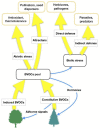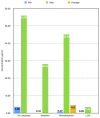Forest Volatile Organic Compounds and Their Effects on Human Health: A State-of-the-Art Review
- PMID: 32906736
- PMCID: PMC7559006
- DOI: 10.3390/ijerph17186506
Forest Volatile Organic Compounds and Their Effects on Human Health: A State-of-the-Art Review
Abstract
The aim of this research work is to analyze the chemistry and diversity of forest VOCs (volatile organic compounds) and to outline their evidence-based effects on health. This research work was designed as a narrative overview of the scientific literature. Inhaling forest VOCs like limonene and pinene can result in useful antioxidant and anti-inflammatory effects on the airways, and the pharmacological activity of some terpenes absorbed through inhalation may be also beneficial to promote brain functions by decreasing mental fatigue, inducing relaxation, and improving cognitive performance and mood. The tree composition can markedly influence the concentration of specific VOCs in the forest air, which also exhibits cyclic diurnal variations. Moreover, beneficial psychological and physiological effects of visiting a forest cannot be solely attributed to VOC inhalation but are due to a global and integrated stimulation of the five senses, induced by all specific characteristics of the natural environment, with the visual component probably playing a fundamental role in the overall effect. Globally, these findings can have useful implications for individual wellbeing, public health, and landscape design. Further clinical and environmental studies are advised, since the majority of the existing evidence is derived from laboratory findings.
Keywords: biogenic volatile organic compounds; forest; limonene; phytoncides; pinene; preventive medicine; public health; review.
Conflict of interest statement
The authors declare no conflict of interest.
Figures




Similar articles
-
Temporal and Spatial Variability of Volatile Organic Compounds in the Forest Atmosphere.Int J Environ Res Public Health. 2019 Dec 5;16(24):4915. doi: 10.3390/ijerph16244915. Int J Environ Res Public Health. 2019. PMID: 31817339 Free PMC article.
-
Compartment specific chiral pinene emissions identified in a Maritime pine forest.Sci Total Environ. 2019 Mar 1;654:1158-1166. doi: 10.1016/j.scitotenv.2018.11.146. Epub 2018 Nov 10. Sci Total Environ. 2019. PMID: 30841390
-
Evaluating In Silico the Potential Health and Environmental Benefits of Houseplant Volatile Organic Compounds for an Emerging 'Indoor Forest Bathing' Approach.Int J Environ Res Public Health. 2021 Dec 27;19(1):273. doi: 10.3390/ijerph19010273. Int J Environ Res Public Health. 2021. PMID: 35010532 Free PMC article.
-
Volatile organic compounds at swine facilities: a critical review.Chemosphere. 2012 Oct;89(7):769-88. doi: 10.1016/j.chemosphere.2012.04.061. Epub 2012 Jun 7. Chemosphere. 2012. PMID: 22682363 Review.
-
Role of Biogenic Volatile Organic Compounds (BVOC) emitted by urban trees on ozone concentration in cities: a review.Environ Pollut. 2013 Dec;183:71-80. doi: 10.1016/j.envpol.2013.03.012. Epub 2013 Apr 15. Environ Pollut. 2013. PMID: 23597803 Review.
Cited by
-
Effect of forest cover on lung cancer incidence: a case study in Southwest China.Front Public Health. 2024 Oct 4;12:1466462. doi: 10.3389/fpubh.2024.1466462. eCollection 2024. Front Public Health. 2024. PMID: 39430708 Free PMC article.
-
Psychophysiological and Metabolomics Responses of Adults during Horticultural Activities Using Soil Inoculated with Streptomyces rimosus: A Pilot Study.Int J Environ Res Public Health. 2022 Oct 8;19(19):12901. doi: 10.3390/ijerph191912901. Int J Environ Res Public Health. 2022. PMID: 36232200 Free PMC article.
-
Effects of Forest-Based Interventions on Mental Health: A Meta-Analysis of Randomized Controlled Trials.Int J Environ Res Public Health. 2022 Apr 17;19(8):4884. doi: 10.3390/ijerph19084884. Int J Environ Res Public Health. 2022. PMID: 35457755 Free PMC article.
-
Simulated Forest Immersion Therapy: Methods Development.Int J Environ Res Public Health. 2022 Apr 28;19(9):5373. doi: 10.3390/ijerph19095373. Int J Environ Res Public Health. 2022. PMID: 35564767 Free PMC article.
-
To stress or not to stress: Brain-behavior-immune interaction may weaken or promote the immune response to SARS-CoV-2.Neurobiol Stress. 2021 May;14:100296. doi: 10.1016/j.ynstr.2021.100296. Epub 2021 Jan 27. Neurobiol Stress. 2021. PMID: 33527083 Free PMC article.
References
-
- Went F.W. Blue hazes in the atmosphere. Nature. 1960;187:641–643. doi: 10.1038/187641a0. - DOI
-
- Guenther A.B., Jiang X., Heald C.L., Sakulyanontvittaya T., Duhl T., Emmons L.K., Wang X. The Model of Emissions of Gases and Aerosols from Nature version 2.1 (MEGAN2.1): An extended and updated framework for modeling biogenic emissions. Geosci. Model Dev. 2012;5:1471. doi: 10.5194/gmd-5-1471-2012. - DOI
-
- Niinemets Ü., Monson R.K. Biology, Controls and Models of Tree Volatile Organic Compound Emissions. Springer; Dordrecht, The Netherlands: 2013.
Publication types
MeSH terms
Substances
LinkOut - more resources
Full Text Sources
Other Literature Sources
Medical

